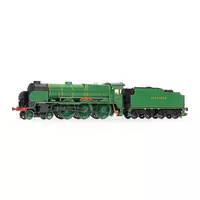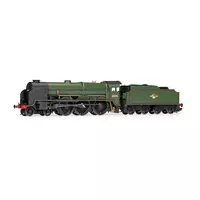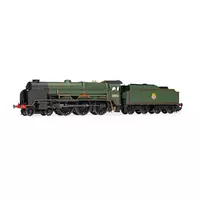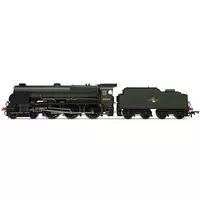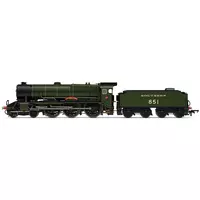Manufacturer catalogue image - please note that pre-release images may be CAD renders or CGI images rather than photographs
Prototype Era
Era 4 (1948 to 1956) British Railways Early Crest
Manufacturer description
In order to cope with the steadily increasing weight of express passenger traffic on the Southern Railway in the early years of Grouping, Richard Maunsell, the Chief Mechanical Officer, needed a locomotive that was more powerful than the King Arthur class, but one that would still conform to the various gauging and weight issues within the region and still be capable of hauling 500 ton trains at a speed of 55mph.
The new Lord Nelson design had to fit within the profile of the King Arthur class and having previously used a Drummond four cylinder locomotive as a test bed, Maunsell altered the positions of the cranks on the Lord Nelson design to give eight exhaust pulses per revolution, rather than four. The resulting increase in power over the two cylinder design of the King Arthur class was significant. A longer, Belpaire boiler, with a completely differently designed firebox was used, the cab design was similar to the L1 4-4-0 and the bogie was of a new design, being independently coil-sprung.
Maunsell decided to produce one example as a prototype ordered from Eastleigh Works on May 29, 1925, which replaced the last engine on an existing King Arthur build order. The locomotive, No. E850, was completed on August 11, 1926 and after trials at Eastleigh, was sent to Nine Elms for trial running on the Western section mainlines to Bournemouth, Portsmouth and Exeter before moving across to Battersea for trials on the Dover boat trains.
Although areas for improvement were noted, there was enough confidence in the locomotive's design for a further fifteen engines to be ordered; ten on March 13, 1927 and a further five on March 23, 1928. These locomotives were completed at Eastleigh between June 1928 and November 1929 and once the decision was taken to name the class after naval leaders, the Southern Railway's publicity department went to work promoting the introduction, basing their claim of the class being 'the most powerful express locomotive in Britain' on the theoretical tractive power of 33,300lbf.
Both Maunsell and his successor, Oliver Bulleid, bought a number of modifications to the class, the most noticeable being the introduction of smoke deflectors but chimneys, bogie frames and cylinders were all modified, giving a subtle range of external differences over the pre-war appearance of the class.
Post-war, speed recorders and AWS apparatus were added by British Railways but it was the range of tenders that added interest. For most of their service life, the class ran with flat-sided 5000 gallon bogie tenders, but modified Urie style 5000 gallon bogie tenders from the S15 class were also used, along with 4000 gallon six-wheel tenders. The first withdrawal came in May 1961, the last in October 1962 and one locomotive, No.30850 Lord Nelson, was saved for preservation in the National Collection.
Built at Eastleigh in October 1929, 863 Lord Rodney entered traffic at Stewarts Lane, before moving to Nine Elms in October 1938 following the fitting of an experimental large diameter chimney. Moving between these two sheds, Lord Rodney moved to Bournemouth in June 1945, but was at Nine Elms when renumbered under British Railways to 30863 in August 1949. Whilst at Eastleigh in 1956, Lord Rodney had the front end renewed following a collision, but was not withdrawn from traffic until February 1962.
Catalogue listing
Model details
Prototype information
* Class names often change over the lifespan of a locomotive, so this is not necessarily the class name used by the operator in the period modelled.
Supplier links are provided for your convenience and do not guarantee that the product is currently available. RailwayModels.uk is not a representative of these suppliers, but may receive a commission when purchases are made through links on this page.

